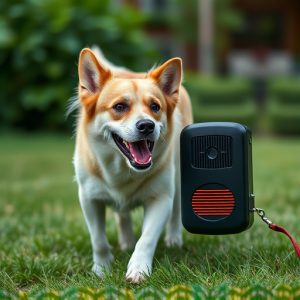Protect Yourself: A Comprehensive Guide to Portable Dog Deterrents
Dog aggression can be managed through understanding triggers like fear or past trauma, maintaining c…….
Dog aggression can be managed through understanding triggers like fear or past trauma, maintaining calmness, and using non-lethal deterrents like Portable Dog Deterrent (PDD) devices. A comprehensive PDD installation guide should cover range, noise level, and ease of use to ensure effectiveness and humane practices. This guide emphasizes strategic placement, secure mounting, and gradual pet training for optimal safety in public spaces, protecting areas like gardens or patios from aggressive dogs. Regular maintenance and vigilance are key best practices.
Personal protection from aggressive dogs is a vital concern, especially when outdoor activities or in urban settings. This comprehensive guide offers practical solutions through understanding dog aggression and selecting an effective portable dog deterrent device. We provide a detailed step-by-step installation and training guide for optimal results, ensuring safety awareness and regular maintenance. Discover the best practices to navigate potential risks and stay secure while enjoying your surroundings, with a focus on user-friendly Portable Dog Deterrent Installation Guide.
- Understanding Dog Aggression and Your Safety
- Choosing the Right Portable Dog Deterrent Device
- Step-by-Step Guide to Installation and Training
- Best Practices for Maintenance and Safety Awareness
Understanding Dog Aggression and Your Safety
Dog aggression can stem from various factors, including fear, territorial behavior, or past trauma. Understanding these triggers is essential when it comes to personal safety. If you’re facing an aggressive dog, remaining calm and avoiding direct eye contact can help de-escalate the situation. A Portable Dog Deterrent (PDD) can be a valuable tool in such scenarios, offering a quick and effective installation guide for your peace of mind.
These devices are designed to deter dogs without causing harm, using sounds or vibrations to communicate danger. By following a simple PDD installation guide, you can learn how to activate these tools effectively. This proactive approach ensures your safety when walking in areas known for aggressive dogs, providing an extra layer of protection that complements your awareness and behavior management skills.
Choosing the Right Portable Dog Deterrent Device
When considering personal protection from aggressive dogs, selecting the right portable dog deterrent device is a crucial step. These devices offer a non-lethal way to deter and scare off potential threats, providing individuals with peace of mind while walking or spending time outdoors. A good Portable Dog Deterrent Installation Guide should focus on features like range, noise level, and ease of use, ensuring the device is effective yet humane.
Choosing the right deterrent involves understanding your surroundings and the behavior of dogs you might encounter. Factors such as frequency and intensity of shock or noise can vary widely among models, so it’s important to select one tailored to your needs. A well-informed decision will not only enhance safety but also promote responsible dog ownership by encouraging deterrence methods that do not cause harm.
Step-by-Step Guide to Installation and Training
Portable Dog Deterrent Installation and Training: A Step-by-Step Guide
Begin by carefully reading the manufacturer’s instructions, ensuring a thorough understanding before installation. This guide is designed for portable dog deterrents, which are ideal for outdoor spaces like gardens or patios. First, select an appropriate location—a strategic spot where the device can effectively cover the desired area without causing harm to nearby objects or people. Mount the deterrent according to the instructions, ensuring stability and placement at a height that deters dogs but is safe for children and pets.
Once installed, train any resident pets to respect the new boundary. Start by acclimating them to the device’s sound, playing it on low settings while rewarding calm behavior. Gradually increase the volume over several sessions until your pet shows no signs of distress. For unfamiliar dogs, use a reward-based training approach when encountering the deterrent in controlled settings. Positive reinforcement can help condition them to avoid the area, effectively protecting your personal space from aggressive dog visits.
Best Practices for Maintenance and Safety Awareness
When it comes to personal protection from aggressive dogs, a well-informed and proactive approach is key. A portable dog deterrent installation guide can be a valuable resource for individuals seeking to enhance their safety in public spaces. This handy tool provides step-by-step instructions on how to deploy effective deterrents, such as sonic devices or spray-based solutions, to create a safe distance between you and potential danger.
Regular maintenance and safety awareness are best practices that should not be overlooked. Ensuring your deterrent is functional and readily available can make all the difference in high-risk areas. Stay vigilant, keep your device at the ready, and follow the guidelines provided by the manufacturer for optimal effectiveness.
When it comes to personal protection from aggressive dogs, armed with the right tools and knowledge, you can enhance your safety significantly. Following our comprehensive guide on choosing and installing a portable dog deterrent device, along with best practices for maintenance and awareness, you’ll be well-equipped to navigate encounters with potentially dangerous canines. Remember, understanding dog aggression is key, and by adhering to this Portable Dog Deterrent Installation Guide, you can ensure your protection while promoting safe interactions between humans and dogs in various settings.


